Greetings and welcome to another Friday wrap-up, featuring all the stories that caught our eye this week in transport, housing, and things that make cities great. Today’s header image shows the Mercury Lane facade of Karanga-ā-Hape station.
As always, huge thanks to our supporters. If you enjoy our posts, you’re welcome to set up a recurring donation – think of it as shouting us a weekly coffee while reading the Friday roundup.
We also love to hear your pitches for guest posts: drop us a line!
The Week in Greater Auckland
- On Monday, Matt looked at the problems with the new government’s approach to drink/ drugged driving.
- Tuesday’s guest post by Christina Robertson was an ode to the orange bus, and how the OuterLink changes are good for the network.
- Wednesday’s post empowers you to speak up on the second Emissions Reduction Plan so it, y’know, reduces emissions. Feedback closes Sunday 25 August!
- And on Thursday, Connor reported on central government’s inexplicable war on localism.
The moral case for urbanism
In a great article for The Spinoff, Joel MacManus explains “why local, street-level design and policy choices are actually among the most important decisions we can make”. The whole thing is a fab read, but here’s a taste:
If you had a machine that could fundamentally improve anyone’s life, or even just make it more statistically likely that their life would improve, you would have a moral duty to use that machine on as many people as possible. City leaders (and, by extension, voters) have their hands on that machine. It is all of our responsibility to ensure that our cities are working as effectively as possible towards the outcome of upward mobility.
[…]
The best possible chance at a better life seems to be found in mixed-income neighbourhoods with different housing typologies, well-designed gathering spaces, strong civic engagement and an active culture of social sports and hobby groups.
Urbanism is about policies that encourage those outcomes. It’s about creating really pleasant, accessible, dense communities with lots of amenities. It’s about shared spaces that encourage interaction and trade, a breadth and variety of housing for all people. It’s about encouraging walking, cycling and public transit, because those transport forms encourage and enable denser living.
[…]
When your neighbourhood is debating a new bike lane, a pedestrian crossing, a park or plaza, a community centre or new housing development, these are the small decisions that determine the quality of density your area can provide, and therefore, the chances that your neighbourhood could change someone’s life.
Related, and also in the Spinoff: is local anti-cycleway sentiment on the way out? Lyric Waiwiri-Smith ventured along to a sparsely attended indignation meeting of the group formerly known as Occupy Garnet Road to find out. We felt both seen and amused by this line in particular:
“There’s one group of cyclists that want a cycleway,” Baldock says, “and it’s the people who don’t wear helmets and have normal clothes.”
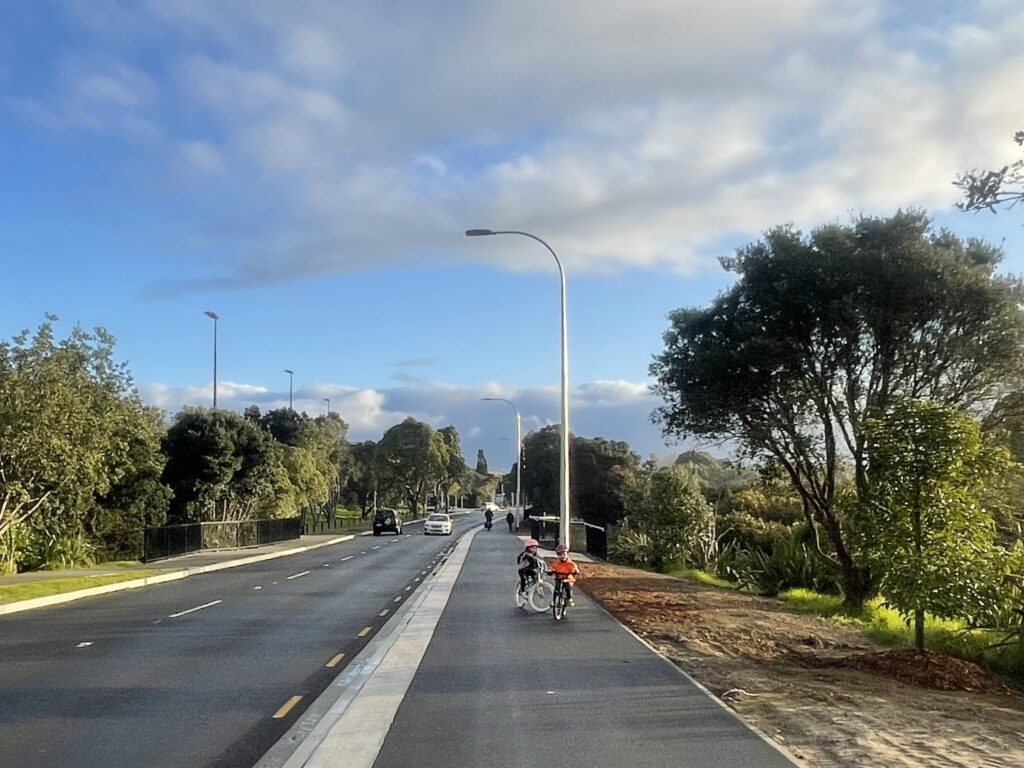
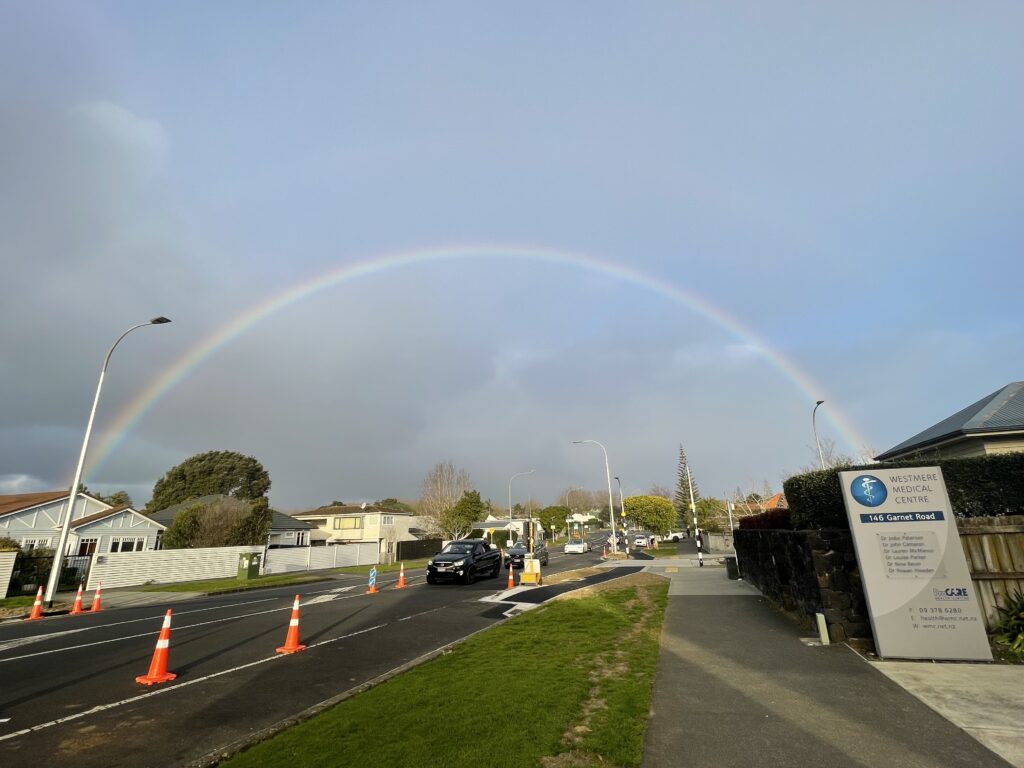
Sydney Metro
The new Sydney Metro has opened to great huzzahs. Here’s a good listen from RNZ on how it’s “the most important transport infrastructure since the opening of the iconic Sydney Harbour Bridge in 1932.” As the ABC describes it:
The new metro is a 15.5km underground line connecting Sydenham in Sydney’s inner west to Chatswood in its north, snaking its way beneath the CBD and diving under Sydney Harbour along the way.
Its turn-up-and-go driverless trains will connect with the existing Metro Northwest line, which has been running automated single-deck trains from Tallawong to Chatswood since 2019.
This blog post captures impressions from day one of the Metro:
The speed and frequency of this new line, trains that run at up to 100km/hr at frequencies of one train per 4 or 5 minutes for most of the day, is just incomprehensible for most Sydney commuters. This city that has spent the past decade celebrating getting train frequencies of 15 minutes for journeys that are still usually slower than driving.
Now Sydney has a line that goes both into the city and allows movement between big suburban centres on the city’s periphery at speeds that make it faster to take the train than it is to drive. Not only that, but at frequencies that Australians usually expect only in Asian or European cities.
This is a transformative, epic project, and sort of what light rail was supposed to be for Auckland: when your heavy rail system is full, and your lines are built out, you need to start building more tracks – the hard way. And not just more tracks, but more stations: the ABC looks at some of the art that’s making this “the city’s first Instagrammable transport project”:
The artworks have also been carefully commissioned to give the stations a sense of place that’s unique to their location and community.
There are recurring themes that connect commuters with Sydney’s natural environment, its First Nations’ heritage and culture, as well as materials and imagery that reference the city’s colonial history.
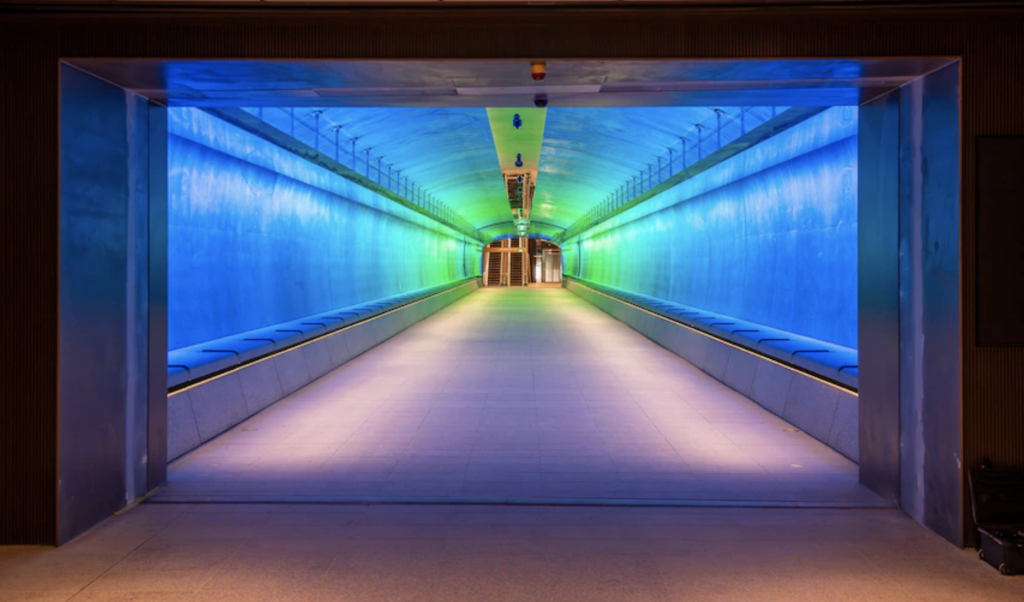
Social media observers noted that politicians were falling over themselves to be associated with the Metro opening, “unlike the state’s last major infrastructure project the Rozelle interchange which had them all ducking for cover.” We fully expect to see exactly the same degree of public buzz – and the same political rush to share the glory – on day one of our CRL.
Speaking of the CRL…
The Mercury Lane facade of Karanga-ā-Hape station has started showing its pretty face this week…
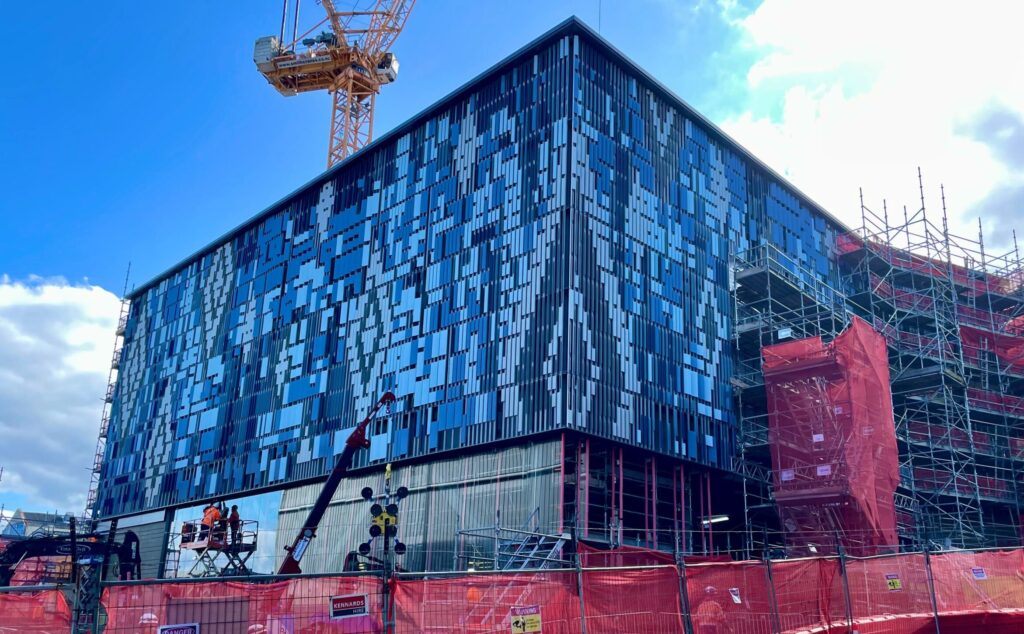
…and CRL has released a photo of the platform level of Te Waihorotiu station, which is 90% complete. It’s getting closer!
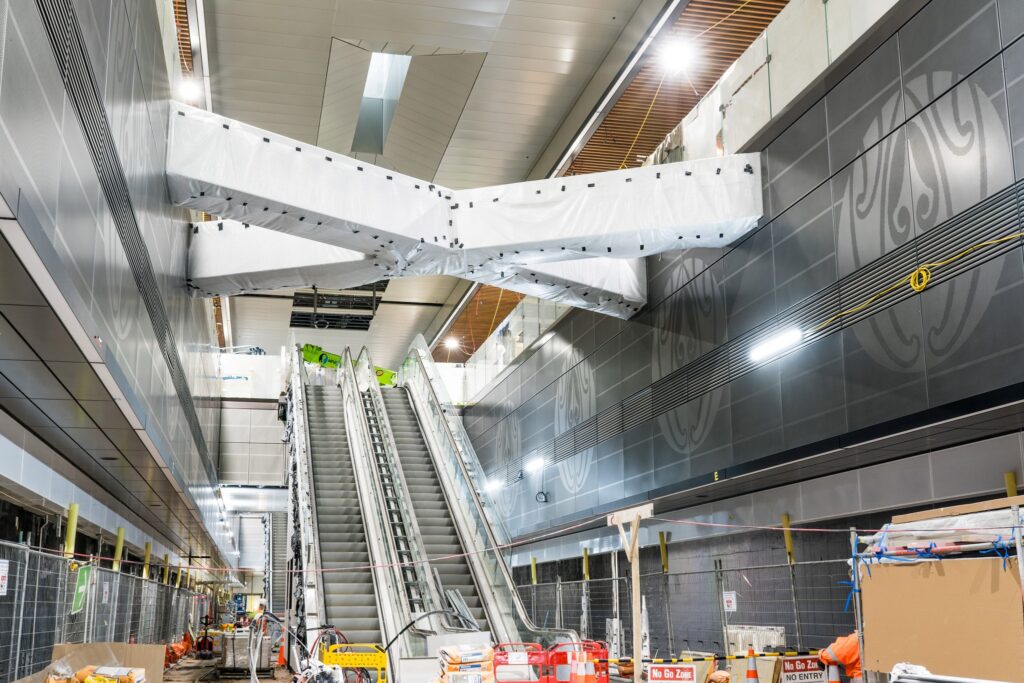
Transport Wiki of the week
Introducing a newly launched fandom page dedicated to the AT Metro network, put together by a group of public transport enthusiasts – one of whom, Frank Leng, explains:
This was inspired by successful initiatives like the HK Bus Wikia, designed to serve as a community hub where like-minded individuals can share knowledge, images, and passion for public transport.
Our goal is to foster a community of transport enthusiasts who can contribute to and benefit from the collective knowledge base we’ve built, forming an invaluable database for both enthusiasts and the general public.
Going underground
The Guardian reports on a bonus feature of the new London Museum, after an accidental revelation during construction:
When a contractor working on the site of the new London Museum at Smithfield market knocked a tentative hole in a bricked-up basement wall, all he could see, peering in with a torch, was a muddy pile of rubble and some scurrying rats.
That unpromising beginning, however, would lead to an “unparalleled” discovery. Behind the wall, once the detritus had been carefully removed, the architects and builders were astonished to find an enormous and beautifully constructed network of subterranean brick vaults that no one, even a year into the ambitious multimillion-pound building project, had known were there at all.
[…]Part of the new museum, due to open in 2026, will be situated underground, at the same level as former Roman streets, the passing Thameslink trains (which will be visible to visitors through a window) and the hidden River Fleet that flows behind thick brick walls just metres away.
Early metro: horses for courses
Did you know: the world’s first urban public transport system was launched in 1662 in Paris, by philosopher and mathematician Blaise Pascal – “a bus service with horse-drawn coaches, each carrying six to eight passengers and running along regular routes.” More about this pioneering Parisian public transport here.
Bikes mean business (and bountiful benefits besides)
In the UK, the new Labour government plans to pour investment into active travel, to enable and encourage more walking and cycling for everyday trips – and to save the country millions in healthcare costs:
The Labour government will invest “unprecedented levels of funding” in cycling and walking as a critical part of plans to improve health and inequality, the new secretary for transport has said.
A national network of safe cycle routes could cut GP appointments “by hundreds of thousands, if not millions a year” by helping people incorporate more physical activity into their lives, according to Louise Haigh, who also sits on the government’s health mission delivery board.
She added that access to safe cycle routes was “essential” to tackling the country’s carbon footprint.
Sounds like something a back-to-basics, cost-of-living government could really get behind, no?
Meanwhile in New Zealand: our Associate Minister of Transport (and also Minister for Mental Health, Minister for ACC, Minister for Tourism and Hospitality, Minister for Youth, and Associate Minister of Health) announced an e-bike charging scheme to help boost access to the already wildly popular and profitable Great Rides around the motu:
One million people enjoy the 23 Great Rides every year including the Alps 2 Ocean Cycle trail and the Otago Central Rail trail, bringing an estimated $1 billion to the regions.
The government has also set the target of raising the economic return to $2 billion per annum across the 23 Great Rides. Tourism and Hospitality Minister Matt Doocey said the investment will unlock economic growth in the regions and support tourism operators to deliver world-class experiences.
“Demand for nature-based, low-impact tourism experiences is expected to increase in the coming years, alongside the availability and popularity of e-bikes,” Doocey said. “We’re bringing cycle trails up-to-speed with modern and reliable e-bike infrastructure, this will help make them more accessible and more appealing to people of all ages and fitness levels.
“As international tourists and Kiwis seek out more environmentally conscious experiences and as e-bikes get cheaper and more advanced, the Great Rides will become even more important to New Zealand’s tourism offering and economic recovery.”
Just to give one example of how profitable and beneficial cycleways can be, on the local level:
Hauraki Rail Trail chief executive Diane Drummond […] said the trail brings approximately $30 million per annum to the local economy.
“Anything that encourages people to get off the couch and get out onto their bikes, is a positive outcome for our communities, improving health and mental wellness for all,” said Drummond.
Goodness: this also sounds like something a back-to-basics, cost-of-living government could really get behind. Maybe even in our towns and cities? Or would that be too ambitious? Anyhow, perhaps the associate transport minister could share some of these numbers with the actual transport minister.
Nevertheless, she persisted
Meanwhile, in our towns and cities, women are getting on bikes with children – despite the disconnected network of safe cycling routes – because they value the fun and ease of a healthy form of transport.
Amanda Chapman features in the Spinoff’s “Big Day Out By Bike” series, with lovely illustrations by Toby Morris, extolling the joy of “flat whites and friends and fixing things”:
After Ori was born, it took a while for Amanda to get back on her bike. Ori was too small for a bike seat, and they didn’t have a bike trailer. “It really affected my mental health. It was a lot harder to get out and do things, or to go from suburb to suburb.” Getting back into cycling took time and a few new pieces of equipment. Once Amanda and her partner Tom bought a trailer, and then later a child’s seat that fits on both their bikes, it made things a lot simpler.
“I found it really positively impacted me as I was able to get out and do things more easily,” she says. Now she appreciates that she can take her bike most places and that it gives her lots of freedom. “If I want to go real fast I can go fast, If I want to go slowly, I can. If I suddenly remember ‘oh I need to drop something off’ I can go and drop something off.” Being outside and moving gives her lots of energy, no matter the weather.
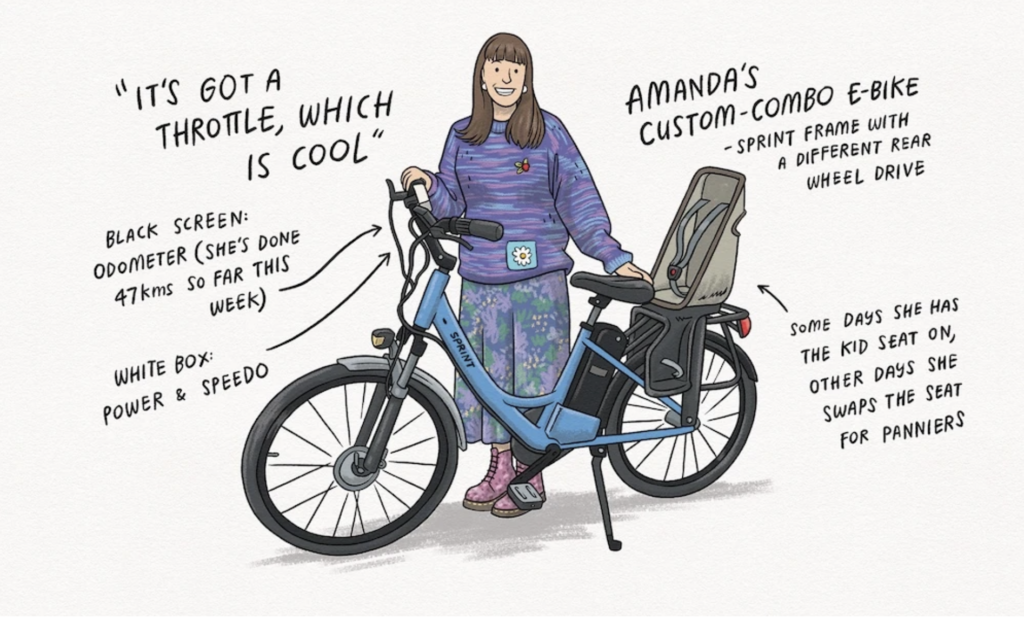
In a similar mood, over on LinkedIn Emma McInnes writes of the surprising amount of exercise her e-bike commute provides for her and her daughter:
Every morning I successfully get my heart rate up by chasing my daycare-resistant child around the apartment with her winter biking-appropriate clothing (10-15 minutes). Once we’re ready (fluffy consumed, teeth unwillingly brushed, docks on, etc.), I haul my laptop, my bag, her bag, and her (+13kg) down the stairs of our walk-up (5 minutes).
I saddle up all the gear + bebe onto our Electric Bike (again, weight lifting). We pedal off to daycare, unload (more weights), and then I spend time settling her into daycare (usually this means more movement / more activity!) (15ish minutes).
By this time, I’m going to be very late for work (sorry The Urban Advisory) so I have to cycle my butt off to mahi, and it’s a workout despite the electrics. I’m always a tad damp on the forehead by the time I make it to Upper Queen St, and slightly out of breath (15 – 20 minute trip). On arrival I do a bit of stretching at coffee machine.
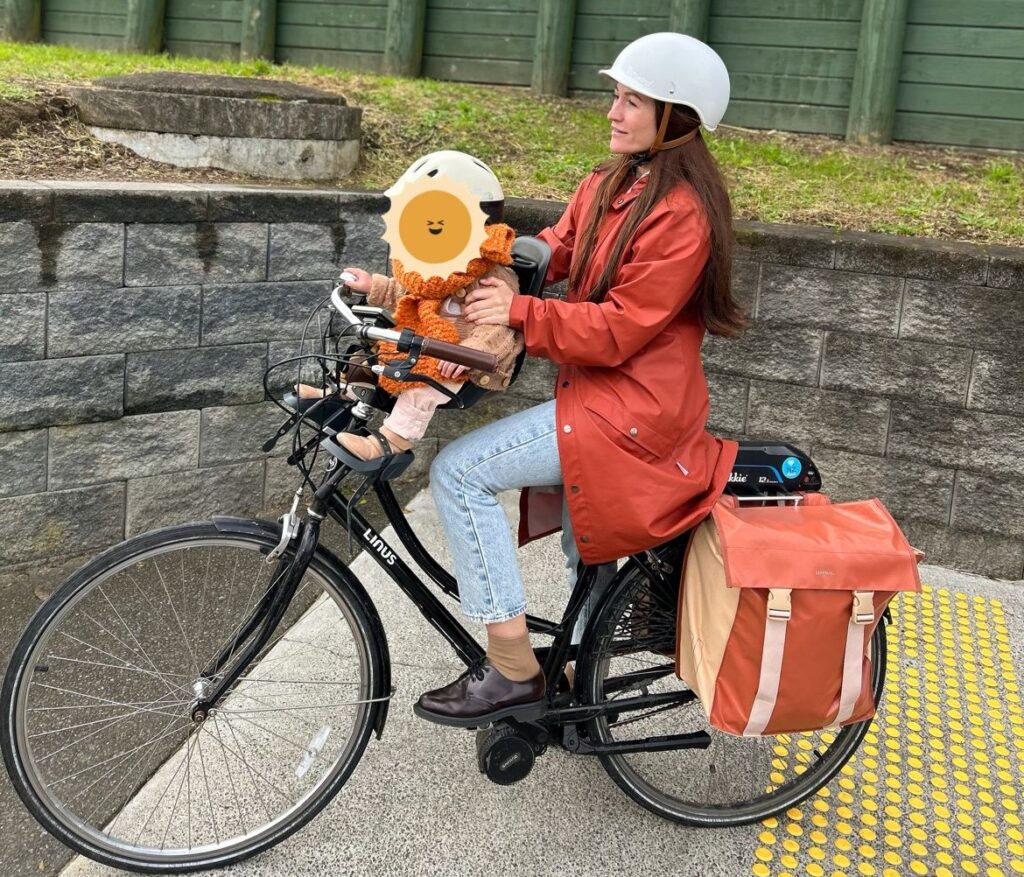
And, in news from India, schoolgirls are leading a silent cycling revolution, reports the BBC:
A new peer-reviewed study published in Journal of Transport Geography reveals remarkable insights about school-going children and cycling in rural India.
The study by Srishti Agrawal, Adit Seth and Rahul Goel found that the most notable rise in cycling in India had occurred among rural girls – increasing more than two times from 4.5% in 2007 to 11% in 2017 – reducing the gender gap in the activity.
“This is a silent revolution. We call it a revolution because cycling levels increased among girls in a country which has high levels of gender inequality in terms of female mobility outside the home, in general, and for cycling, in particular,” says Ms Agrawal.
State-run free bicycle distribution schemes since 2004 have targeted girls, who had higher school dropout rates than boys due to household chores and exhausting long walks. This approach isn’t unique to India – evidence from countries like Colombia, Kenya, Malawi and Zimbabwe also shows that bicycles effectively boost girls’ school enrolment and retention. But the scale here is unmatched.
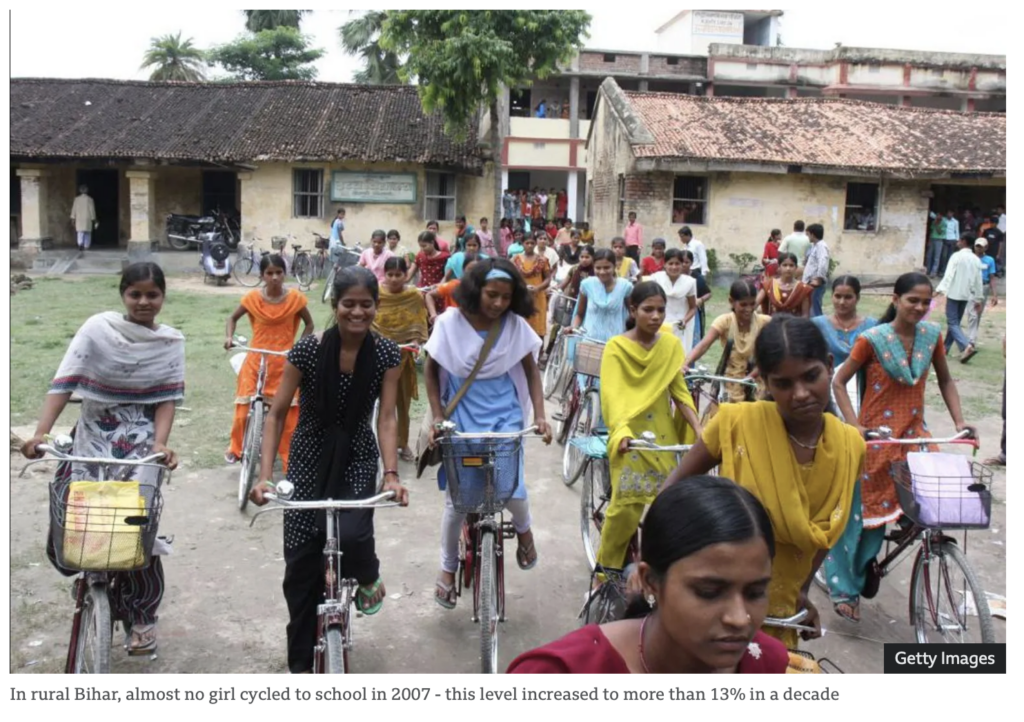
Look, can we just say: this is all very normal and nice. Lavishly accommodating and encouraging more of this sort of thing should be part of a normal transport policy. Indeed, wouldn’t it be weird and nasty if it weren’t? Just saying.
Greenery and greenways
A neat story about a project to regenerate native bush in Oratia:
When the extended Oosterman family bought a section in West Auckland that included a large floodplain, Simon Oosterman’s friends had questions.
But while they worried about insurance, Oosterman was scheming: could he regenerate the Oratia wetlands and plant a native forest on the banks of the stream?
…..
“For the first time in 100 years, just 200 metres will connect 15km of existing native bush with 11km of bush that was planted by the Waitākere Council in the 90s,” he says.
“Normally, people would jump at the opportunity to get publicity, but sometimes funders don’t want to do that.”
The first steps began last week, with clearing an acre of invasive bamboo from the property – a huge forest of towering stalks, that will take a year to properly clear from the soil, he says.

Also cool is the project will enable a future extension of the Oratia Stream Path:
Physical connections are as important as emotional ones: Auckland Council has plans to build connected pathways throughout West Auckland, but some of them will go through private land – this is the case in Oratia at Little Kaurimu Farm.
Oosterman and the donors agreed the project will include quality fencing for 500 metres along the proposed pathway, but the council will need to do the rest – something Waitākere Councillor Shane Henderson is excited about.
“I’m very keen to work with the group, and lobby at my end to see what money can be found to do that, because nature is to be enjoyed,” Henderson says.
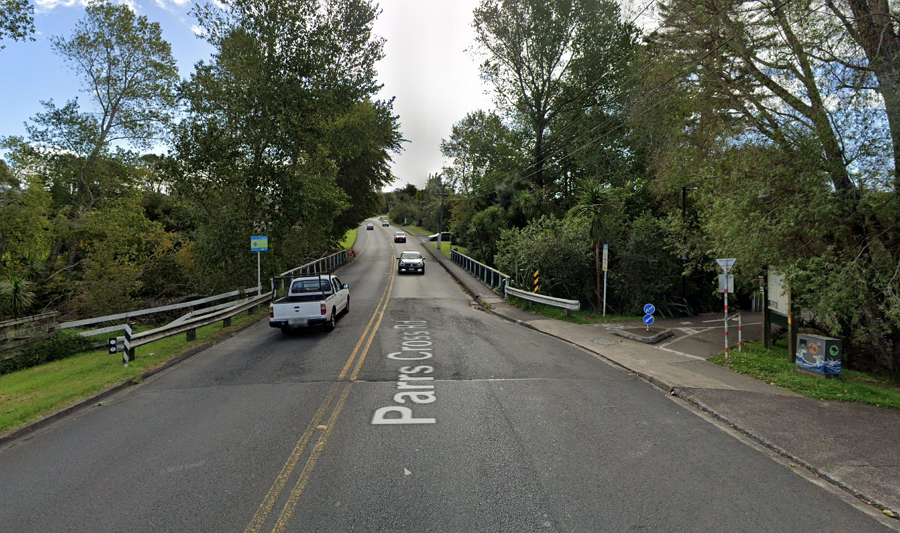
That’s us for the week; as always feel free to drop some links in the comments below, and have a lovely weekend!


 Processing...
Processing...
Being as NZ is 5 to 10 years behind the rest of the world and by the looks of things, most countries resitance is falling away against cyclelanes other than in some places in the States it feels like that culture war will slowly die out here, especially if we can learn to just build them simple and cheaply.
As for Sydney Metro, it just makes you realise how absolutely insane it was to think we a city of 1.7 million should build an underground driverless system to suburbs like Mount Roskill lol. Should have and always will just need to be a simple on street Light Rail system
Culture war for cycle lanes is unfortunately just heating up. The majority of the population is unfortunately “over” cycleways which is a real shame as they had good potential. I think the way Sydney metro has been constructed as a long distance commuter route is interesting with the minimal seating it provides if I was to go from Rouse Hill to Central that’s a long time to be possibly standing depending on how busy it gets.
Who says the majority of the population is “over” cycleways? They aren’t just going to go away because some vocal people are against them.
And in terms of standing, I mean if you get on at Rouse Hill you’ll get a seat if it’s the first stop, and if you’re going the other way well that’s train life, people get on, get off. Seats become available, etc.
Yes the Central to Rouse Hill route will be a pain. Its train life sure but normally not a Sydney thing you’re almost always guaranteed a seat on the existing double deck rolling stock.
Normally on routes, the ones starting from further out get a seat as no one is on it yet, and as you get closer to the dense areas passengers will be getting on /off more frequently so it should work out.
Don’t worry, this Radar person just throws ‘trust me bro reckons’ out like lollies at a kids party. Don’t ask for any evidence other than an election result and a recent poll, that’s all you need. If you disagree you have to wait another 2 years or so.
You are completely wrong when you say “Culture war for cycle lanes is unfortunately just heating up.” I have been cycling for more than 15 years in Auckland and over that time I seen a marked improvement in the attitude to cyclists and cycleways and the numbers keep growing. So despite some politician’s wishful thinking the reality is quite different. As always the majority of people just get on and do what they want to do, regardless on the noisy minority. The numbers below are just the tip of the iceberg as it only counts bikes that cross a counter. many local trips will not be countered.
Here is the data from AT’s automatic cycle counters.
At 26 count sites: A total of 3.28 million cycle movements were recorded from February 2023 to January 2024, marking a 14.6% increase compared to the previous 12 months. 299,833 cycle movements were recorded in January 2024, representing a 25.6% increase compared to January 2023.
The target value for FY 23/24 has been met.
Like I say, the response here will be ‘Nationa just got a good poll result’ don’t worry about things like the massive support for cyclelanes such as the inner west consultation which has been consulted on numerous times and every time the support increases.
Someone tell Christchurch that no one wants cycleways…
“Should have and always will just need to be a simple on street Light Rail system”: yes if it was just “to suburbs like Mount Roskill”, its when you start getting out to Mangere and Airport that LR starts to become less suitable. Personally I think they should have only built LR to Mt Roskill and encouraged people to live closer.
It’s the airport, not Hamilton.
For the mere 10kms between Onehunga and the airport, and with about 5 stops including Mangere, LR was a great solution.
LR from the airport is like the old days when driving from the airport to city involved getting off at Queenstown Road and driving through 50km/hr residential streets. Its usable, but not a great solution.
I’d still choose that option, but lets not pretend it didn’t have its flaws.
Who cares what roads it does or doesn’t run on? You only worry about the time between your stations. 7km from Queen street to Mount roskill so about 15 minutes.
And a lot of people live in those suburbs. A quarter million from town to the airport. Why bypass them?
Yes, bring back the surface light rail plan!
It would hoot along SH20/20A and so turns out pretty good time. The current Southern Line train is not that quick as a comparison.
The whole point of surface light rail was/is lower costs and quicker construction – and we’re at a point where we *need* action to reduce car dependancy. Some mass transit’s better than no mass transit at all
Plus, surface light rail’s not much slower than the heavy rail/light metro options really. Is 5-10 minutes saved really worth more than double the cost?
Not only is surface LR almost as fast, its far more agile. HR can’t handle.as many stations.
LR sure ain’t perfect, but we should not let best be the enemy of better.
There are cities in Europe with populations less than 500000 with 1 or even 2 automated metro line (Rennes, Lausanne or Brescia for instance), so it’s not crazy to imagine a proper metro system in Auckland too. That’s being said, a ground surface tram is also fine. In my opinion, both types are valid transit options as long as they are properly implemented and realised.
Also it’s funny to see that Paris in 1662 already had better transit planning that some places today in 2024…
Good stuff with Te Wai Horotiu station as well, looking forward to ride the CRL in my next NZ visit.
And our second largest city doesn’t have a single rail line nor any BRT.
It’s farcical.
It would seem that Matt Doocey,as Associate Transport Minister,gets bikes. This is good news as his main portfolio ,mental health, will be the biggest benefactor of increased cycling.
From personal experience ,cycle commuting,with at stages ,some train,made working in Auckland,a much more tolerable experience,could even arrive at work with a smile in the pouring rain. Getting home was even better,as it was invariably quicker than cars.
The British Labour Party,are on the right track,linking active modes,to health benefits,this would seem difficult to argue against,even the most idealistic politicians,cannot ignore the obvious.
“Associate Minister of Transport (and also Minister for Mental Health”
Yes I noticed that a while back too, and thought good combination.
I think this is the first eScooter charging fire I’ve heard of in NZ causing a building evacuation. Food for thought around battery standards and charging safety. https://www.nzherald.co.nz/nz/smoke-billows-from-auckland-apartments-residents-evacuated/37C2XW2O2JAEFK5NACI4CUIZ4Q/
There might be some implications for businesses allowing their employees to charge these at work too. I can imagine the risk of fire (or at the least, fire alarms emptying offices semi-regularly) will be under assessment now.
So… no smart phones or phone chargers either?
My work has allocated a room in the basement as a scooter park so if there is a fire it is limited to one room that has good fire systems.
Apart from the fore risk, if businesses allow their employees to charge their eScooters at work should they also allow employees to charge their eCars? Would there be meters and a charge for that?
How about the IC vehicles? Will the business allow their employees to refuel their petrol and diesel powered vehicles at work?
And how about those factories and mills shutting down because of the cost of electricity? Should we have more of those closing down so that city workers can charge their vehicles during business hours?
Device has to respond to charger – wrong charger = fire. Difficult for public chargers, perhaps?
“our Associate Minister of Transport (and also Minister for Mental Health, Minister for ACC, Minister for Tourism and Hospitality, Minister for Youth, and Associate Minister of Health) announced an e-bike charging scheme”
Given this Government, when I first read this, I assumed it meant they would start charging people for using e-bike
lol
I had my say on the Te Ara Tukutuku Plan at Wynyard Quarter and suggested that the trees and plants be natives. They are threatened and need support. Visiters like to see Tuis, Bellbirds, fantails and Kereru in our very special trees.
That’s very much the intent of the design, which includes a native plant nursery for the public to learn about that.
Great note on Pascal’s public transport system. My only question – was the circular yellow route subject to bunching of services, just like our Link buses today?!
Great question. Enquiring minds want to know! Yea, or … neigh?
Yes it would have been susceptible to bunching like any loop route, and would have needed timing stops or similar to keep it even.
western sydney build rail through before housing and shops…when auckland airport was surrounded by farmland, nothing. when west was surrounded by farmlands, nothing. now it’s all build up and no place for rail, not even road widening for a bus lane…awesome planning we got.
We hope the Prime Minister’s visit to Sydney infrastructure sparks some real action.
They were only there to hear about PPPs and tunnels. They will take that info and apply it to roads.
All the talk about Sydney’s new metro line being “transformational”, meanwhile Kiwirail has the stretch goal of one additional rail line in the next 30yrs.
Can’t people see just how backward and behind the rest of the world we are on this stuff?
Galaxy Brain says they’d argue that NZ is just being ahead of the times for the post-apocalypse. I mean do you see anyone in “Mad Max” using public transport? Its all cars and the occasional flying thing!
Yes, hope the PM took note, but think he was only in Sydney before it opened.
Kiwirail, one line? Didn’t even know they had one line on the table.
Avondale-Southdown.
Was in their recent 30yr plan.
Question, regarding the new stations; what is the purpose/function/use of the space above the actual entries?
The new stations look similar, being boxes that are neither simple street level entrances to go underground, nor tall structures, e.g. apartments.
They seem a bit strange…
I think at least one (the City Centre one?) houses control equipment in the upper floor). I also think some were future-proofed for development above, but am unsure if I am remembering that correctly.
As I understand our funding regimes, it is quick difficult for public infrastructure to actually provide such add-ons (residential or office above) on their own – i.e. without an outside partner funding them, because the rules basically just say no. And I guess the CRL already had a big enough ticket of work for it to saddle itself with (for example) planning a residential skyscraper above and then finding critics – correctly or incorrectly – predicting that it was going to all end in financial grief that authorities should not have gotten involved in…
“quite dificult” not “quick difficult”
The Sydney Metro is amazing, epic art work designed spots, that link has a video worth watching.
Wow, CRL starting to look good! So exciting.
Notice all of those Indian school girls on their cycles with no helmets?
Good video on the network of climate shelters in Barcelona and related.